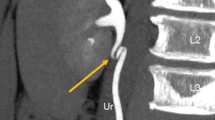Abstract
Aim
The aim of the current trial was to evaluate the learning curve of access creation through solo ultrasonography (US)-guided percutaneous nephrolithotomy (PCNL), and clarify the technical details of the procedure.
Materials and methods
We evaluated the first 240 solo US-guided PCNLs performed by one surgeon at our institution. The data including the puncture procedure, access characteristics, access-related complications and stone-free rates were assessed in four sequential groups.
Results
The puncture duration and number of times decreased from a mean of 4.4 min and 2.1 times for the first 60 patients to 1.3 min and 1.2 times for the last 60 patients. There was a significant decrease from 3.7 min and 1.8 times for the 61th–120th patients to 1.5 min and 1.3 times for the 121th–180th patients. All of the access-related severe bleeding appeared in the first 120 patients, while perforations only occurred in the first 60 patients. The stone-free rates were 68.3, 83.3, 90.0, and 93.3% for the four sequential groups.
Conclusion
The increase in experience lead to an improvement in the puncture duration and times, which accompany with better stone-free rates and lower complications. We propose that 60 operations are sufficient to gain competency, and a cutoff point of 120 operations will allow the surgeon to achieve excellence in the solo US-guided PCNL.


Similar content being viewed by others
References
Xiao B, Hu W, Zhang X et al (2016) Ultrasound-guided mini-percutaneous nephrolithotomy in patients aged less than 3 years: the largest reported single-center experience in China. Urolithiasis 44(2):179–183
Gadzhiev N, Brovkin S, Grigoryev V et al (2015) Sculpturing in urology, or how to make percutaneous nephrolithotomy easier. J Endourol 29(5):512–517
Li H, Chen Y, Liu C et al (2013) Construction of a three-dimensional model of renal stones: comprehensive planning for percutaneous nephrolithotomy and assistance in surgery. World J Urol 31(6):1587–1592
Zuckerman DA, Desai A (2011) Nephrostolithotomy. Semin Interv Radiol 28(4):438–443
Karami H, Rezaei A, Mohammadhosseini M et al (2010) Ultrasonography-guided percutaneous nephrolithotomy in the flank position versus fluoroscopy-guided percutaneous nephrolithotomy in the prone position: a comparative study. J Endourol 24(8):1357–1361
Agarwal M, Agrawal MS, Jaiswal A et al (2011) Safty and efficacy of ultrasonography as an adjunt to fluoroscopy for renal access in percutaneous nephrolithotomy (PCNL). BJU Int 108(8):1346–1349
Basiri A, Ziaee AM, Kianian HR et al (2008) Ultrasonographic versus fluoroscopic access for percutaneous nephrolithotomy: a randomized clinical trial. J Endourol 22(2):281–284
Li X, Long Q, Chen X et al (2014) Real-time ultrasound-guided PCNL using a novel SonixGPS needle tracking system. Urolithiasis 42(4):341–346
Rodrigues PL, Rodrigues NF, Fonseca J et al (2013) Kidney targeting and puncturing during percutaneous nephrolithotomy: recent advances and futureperspectives. J Endourol 27(7):826–834
Lojanapiwat B (2013) The ideal puncture approach for PCNL: fluoroscopy, ultrasound or endoscopy? Indian J Urol 29(3):208–213
Falahatkar S, Neiroomand H, Enshaei A et al (2010) Totally ultrasound versus fluoroscopically guided complete supine percutaneous nephrolithotripsy: a first report. J Endourol 24(9):1421–1426
Gamal WM, Hussein M, Aldahshoury M et al (2011) Solo ultrasonography-guided percutanous nephrolithotomy for single stone pelvis. J Endourol 25(4):593–596
Fei X, Li J, Song Y et al (2014) Single-stage multiple-tract percutaneous nephrolithotomy in the treatment of staghorn stones under total ultrasonography guidance. Urol Int 93(4):411–416
El-Assmy AM, Shokeir AA, Mohsen T et al (2007) Renal access by urologist or radiologist for percutaneous nephrolithotomy-is it still an issue? J Urol 178(3 Pt 1):916–920
Aslam MZ, Thwaini A, Duggan B et al (2011) Urologists versus radiologists made PCNL tracts: the UK Experience. Urol Res 39(3):217–221
Wang Y, Lu Z, Hu J et al (2014) Renal access by sonographer versus urologist during percutaneous nephrolithotomy. Urol J 10(4):1035–1039
Zeng G, Zhao Z, Zhong W et al (2013) Evaluation of a novel fascial dilator modified with scale marker in percutaneous nephrolithotomy for reducing the X-ray exposure: a randomized clinical study. J Endourol 27(11):1335–1340
Isac W, Rizkala E, Liu X et al (2013) Endoscopic-guided versus fluoroscopic-guided renal access for percutaneous nephrolithotomy: a comparative analysis. Urology 81(2):251–256
Shah AK, Xu K, Liu H et al (2013) The “visual dilator system”: initial experimental evaluation of an optical tract dilation technique in percutaneous nephrolithotomy. J Endourol 27(7):908–913
Xu Y, Wu Z, Yu J et al (2012) Doppler ultrasound-guided percutaneous nephrolithotomy with two-step tract dilation formanagement of complex renal stones. Urology 79(6):1247–1251
Author information
Authors and Affiliations
Corresponding author
Ethics declarations
Disclosure statement
Authors Weimin Yu, Ting Rao, Xing Li, Yuan Ruan, Run Yuan, Chenglong Li, Haoyong Li and Fan Cheng declare that they have no conflict of interest.
Ethical approval
All procedures performed in studies involving human participants were in accordance with the ethical standards of the institutional and/or national research committee and with the 1964 Helsinki Declaration and its later amendments or comparable ethical standards.
Additional information
Weimin Yu and Ting Rao have contributed equally to this work.
Weimin Yu and Ting Rao are co-first authors.
Rights and permissions
About this article
Cite this article
Yu, W., Rao, T., Li, X. et al. The learning curve for access creation in solo ultrasonography-guided percutaneous nephrolithotomy and the associated skills. Int Urol Nephrol 49, 419–424 (2017). https://doi.org/10.1007/s11255-016-1492-8
Received:
Accepted:
Published:
Issue Date:
DOI: https://doi.org/10.1007/s11255-016-1492-8




